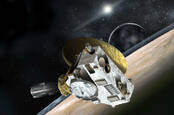This article is more than 1 year old
Japanese astronomers find tiniest Kuiper Belt object yet – using cheap 'scopes and off-the-shelf CMOS cameras
Boffinry on a shoestring finds icy chunk that's just 1.3km across
A plucky group of low-budget astronomers has pulled off quite a coup by spotting the smallest object yet in the Kuiper Belt, the donut of icy objects swirling around in the outer Solar System.
Amazingly, the OASES (Organized Autotelescopes for Serendipitous Event Survey) team made the find using a pair of small 28cm (11-inch) "low cost" telescopes plus some off-the-shelf CMOS cameras. From the rooftop of a school in Miyako Island, Japan, over a period of 60 hours, they monitored 2,000 suns – watching for the telltale dip in luminosity that occurs when an object briefly obscures the view of a star from Earth.
As a result, according to a paper published in Nature Astronomy, they found the smallest known object in the Kuiper Belt, a chunk of material just 1.3km (0.8 miles) in radius.
The Kuiper belt stretches from Neptune's orbit to about 50 AUs from our Sun, and is home to millions of bits of icy volatiles and larger chunks including minor planets – Pluto is one of these. This latest object spotted by the boffins is the first entity belonging to a class of bodies with radii measuring between 1km and 10km, whose existence was predicted more than 70 years ago.
"This is a real victory for little projects," said Ko Arimatsu, first author of the paper and a researcher at the National Astronomical Observatory of Japan.

Crispest image yet of Ultima Thule arrives on Earth, but grab a coffee while the rest downloads
READ MORE"Our team had less than 0.3 per cent of the budget of large international projects. We didn't even have enough money to build a second dome to protect our second telescope. Yet we still managed to make a discovery that is impossible for the big projects."
Pluto, the dwarf planet with a radius of 1,187km, is the largest object yet found in the belt. NASA researchers are currently probing Ultima Thule, another interesting specimen some 16km across made up of two bodies caught in the act of colliding together.
This new find suggests that the current theory of planetesimals like Ultima Thule and the new object are the building blocks of planets is probably correct.
"Now that we know our system works, we will investigate the Edgeworth-Kuiper Belt in more detail. We also have our sights set on the still undiscovered Oort Cloud out beyond that," said Arimatsu. ®
